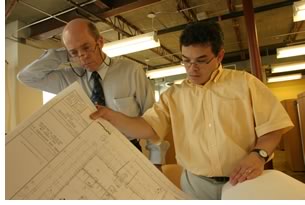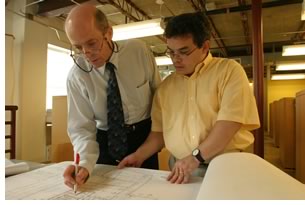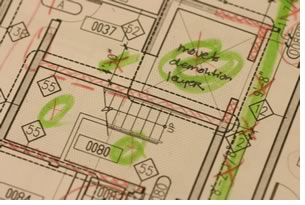

02/2005
by James B. Atkins, FAIA, and Grant A. Simpson, FAIA
 Risk management is not a standard course in architecture school. It
is not a topic on The Architect Registration Examination. Yet there are
many seminars on the subject presented each year at the National AIA
Convention, and professional publications address the topic frequently.
The AIA Risk Management Committee is one of the two most funded committees
in the Institute.
Risk management is not a standard course in architecture school. It
is not a topic on The Architect Registration Examination. Yet there are
many seminars on the subject presented each year at the National AIA
Convention, and professional publications address the topic frequently.
The AIA Risk Management Committee is one of the two most funded committees
in the Institute.
Unfortunately, many architects believe risk management is a remote activity and should be discharged by the “technical guys” in the back room, out of sight of clients. Our profession is actually heavily influenced by risk management, yet there are no checklists or descriptive processes. Why is it so enigmatic? Why is it so important? Why should we be concerned with something so distant from architecture? Or is it so distant?
Only in the last 30 years have we had to worry about our risks. It all began about the time the Request for Information appeared on the scene. Up until then contractors didn’t write down the questions they asked the architect. They didn’t keep track of what their questions were or how they were answered. They were only concerned with building the project, collecting their fee, and moving on to the next job.
 Today, as you know, things are quite different. Our documents are scrutinized
in excruciating detail for conflicting, duplicated, or missing information.
The RFI process has become a struggle, with architects considering their
answers to be “supplemental instructions,” and contractors
often claiming them to be added scope. RFIs and submittal tracking logs
are now viewed as the contractor’s primary tools for making a case
against the architect. Architects are condemned if we don’t answer
any and all questions quickly or correctly. We are also condemned if
we answer correctly, with the presumption that the question was necessary
because the drawings were deficient in some way.
Today, as you know, things are quite different. Our documents are scrutinized
in excruciating detail for conflicting, duplicated, or missing information.
The RFI process has become a struggle, with architects considering their
answers to be “supplemental instructions,” and contractors
often claiming them to be added scope. RFIs and submittal tracking logs
are now viewed as the contractor’s primary tools for making a case
against the architect. Architects are condemned if we don’t answer
any and all questions quickly or correctly. We are also condemned if
we answer correctly, with the presumption that the question was necessary
because the drawings were deficient in some way.
The result has been an alarming increase in claims and litigation against architects. This has threatened the existence of many insurance providers, and premiums and deductibles have risen as they attempt to stay alive. Meanwhile, insurance companies and defense lawyers are preaching risk management. They tell us to proceed with great caution, and they warn against project types of higher risk.
It’s an attitude
In upcoming articles on the subject, we will not address risk management
as a single subject, but instead we will address the implications of
risk management in the various areas of our profession. This is because
risk management is not so much a subject as an attitude. It is more
an approach to business than it is a part of business. Achieving success
in architecture in today’s treacherous industry is dependent
upon how you apply relevant risk management as you go about providing
your professional services.
 Our subjects will cover essentials such as good contracts and effective
documentation. We will look at the risks that arise from our plans and
specifications and the minefield of construction administration liabilities.
We will review high risk areas in project delivery, such as the broadly
misunderstood aspects of fast track and the varying expectations of construction
management. We will also examine risks associated with the contractor’s
work responsibilities and how easily the architect can assume them if
not prepared and knowledgeable. In virtually every article, we will examine
the benefits of communicating with and understanding your clients and
their expectations of your performance.
Our subjects will cover essentials such as good contracts and effective
documentation. We will look at the risks that arise from our plans and
specifications and the minefield of construction administration liabilities.
We will review high risk areas in project delivery, such as the broadly
misunderstood aspects of fast track and the varying expectations of construction
management. We will also examine risks associated with the contractor’s
work responsibilities and how easily the architect can assume them if
not prepared and knowledgeable. In virtually every article, we will examine
the benefits of communicating with and understanding your clients and
their expectations of your performance.
How did things get this way?
First, let’s look at how we got into this fine mess. What happened
to cause the contractor to start worrying more about keeping score than
keeping in budget and on schedule? What caused us to start dissecting
words and using those cover-your-assets phrases?
The worm began to turn back in the ’50s when the courts ruled that you could sue someone although you were not contracted with them. The contractual relationship, known in legal terms as privity, ceased to be an absolute requirement for filing suit, and architects began to experience the joys of being served with legal papers. The climate quickly changed for architects from never being involved in lawsuits to almost always being involved.
As a result, architects began to worry more about semantics than about their services. Inspection and supervision gave way to observation and just being generally familiar with the work. Any certifications that were made had to be based on the “best of our knowledge, information, and belief”. Architects had to start dancing with the legal aspects of their services because they were becoming targets in claims and legal actions.
 Insurance plays a role
Insurance plays a role
But architects didn’t really become a viable target for claims
until they acquired professional liability insurance. The insurance policy
gave the plaintiffs a measurable goal for claim damage awards. Professional
liability insurance was created for architects and engineers by Victor
O. Schinnerer in 1957 to protect against a very real threat. But one
has to wonder if the policy itself has become the desired target. Could
this response to a need have actually helped to seal our fate? This phenomenon
will be explored in a later article.
Claims against design professionals typically allege negligence. That is, a negligent act or failure to act by the architect in the performance of professional services. In today’s design industry everyone keeps score. Contractors want additional general conditions costs if the architect fails to act quickly enough, and owners want to be compensated for anything that is added to the job after the contract is signed. This is because of the growing perception that almost everything is the architect’s fault. Any error or omission or duplication is perceived as caused in some way by the design professional. This was explored in a previous AIArchitect article entitled, “A Loss Cause: An Architect’s Assessment of Errors and Omissions,” If you have ever been involved in a lawsuit, you have experienced firsthand that every mistake that can be divined from your services will be cited as evidence of a “pattern of negligence.”
Nobody’s perfect
This raises the question: Why do they perceive us to be the perpetrator?
Why is it that for years the architect was never thought to be at fault,
and now it is automatically assumed? The accepted definition of “Standard
of Care” does not contain the word perfection. Not for architects
and not for any other profession. So how have contractors and owners
come to demand such performance? Standard of Care as addressed in AIA
Document B511-2001, Guide for Amendments to Owner-Architect Agreements,
emphasizes that “The law . . . does not expect architects
to provide perfect or flawless services or to guarantee or warrant
the results of their services.” Nevertheless, the topic warns
architects that “Use of words or phrases such as ‘highest,’ ‘best,’ or ‘most
qualified’ in relation to the Architect’s standard of care,
increases to extreme levels the standard of performance expected of
the Architect.”
Perhaps architects have brought some of their trouble on themselves with lofty representations that have altered expectations. But there is also a marked demand and expectation for perfect services that prevails in the industry. Clients want architects to sign “redraw at the architect’s sole expense” and “time is of the essence” clauses in contracts, and they frequently demand “100 percent complete” or “fully coordinated” construction documents. This has come about in part because architects do not concern themselves enough with what the general public thinks and knows about realities in their profession. Architects who practice as if they can do no wrong will likely create the same expectation from those with whom they do business.
 So risk management in architecture is much more than just playing it
safe by documenting decisions and securing a good contract. It is also
about education, enlightenment, communications and relationships. It
is partly about improving your product delivery, but it also includes
demanding the full measure of the obligations of others. These practice
adaptations are necessary if we are to overcome the risk challenges that
face us.
So risk management in architecture is much more than just playing it
safe by documenting decisions and securing a good contract. It is also
about education, enlightenment, communications and relationships. It
is partly about improving your product delivery, but it also includes
demanding the full measure of the obligations of others. These practice
adaptations are necessary if we are to overcome the risk challenges that
face us.
A good start
A good place to start is in your own shop. How good is your documentation?
What’s in your laptop? E-mail has become perilous, and the trail
that we leave behind us can be condemning. When you think of documentation
you must think in terms of your complete body of services. Remember,
people are now keeping score on not only what you do but also when
you do it and how fast. It is a lot like keeping a diary. In fact,
many architects keep a personal journal of their projects that much
resembles a diary. They document decisions, events, discussions, and
any other information that chronicles the project delivery. We will
address the essentials of a project journal in detail in a later article
in this series.
A reasonable risk management objective is to have everyone in your office keeping records in a similar manner and with the same thoroughness. This will make training easier, and it will enable data research should you need your records for defending yourself. Your records should be clear and easy to understand. Remember that the person reviewing it later will likely not be an architect, so try to refrain from terminology and jargon that the lay person will not understand. You should also be careful to avoid self criticism in project-related correspondence. At any given time, on any given project, we are likely to take actions that we could have done better, and there is no reason to make a case against yourself by identifying and emphasizing your shortcomings.
The “story” of the design and construction of a project is told primarily through meeting reports, site observation reports, and communicating correspondence such as letters, memoranda, and e-mails. Therefore, it is essential that you manage these media to the greatest extent possible. In addition to the site observation report, it is important that you also manage the project meeting report. After all, they are essentially tools for reporting project progress to the owner. If you issue the report, you will be able to recount the events as you have experienced them, and if you do not issue the report, you will likely read results or opinions that do not coincide with your own. If your contract or your project organizational structure does not allow you to issue the project meeting report, it will be necessary for you to rebut in writing each and every issue and event that is not consistent with your experiences and understandings. Rebuttal is a laborious process that too frequently falls through the cracks of a busy schedule.
 Managing communications and the 24-hour rule
Managing communications and the 24-hour rule
Letters, memoranda, and e-mails must also be managed effectively. Though
seemingly ludicrous, a good rule to follow is not to put anything in
writing that you do not want to see projected on a screen in a courtroom.
This includes criticism of yourself and your consultants, documentation
of any breaches of responsibility, and any unprofessional actions or
behavior. When managing sensitive subjects, it is usually a good idea
to wait awhile after you have written on the subject before sending
it to someone. This is known as the 24-hour rule. This allows you time
to cool down and think over the appropriateness of your response. An
abrupt or rude e-mail “missile” cannot be recovered once
it has been fired.
It is also important to administer your project management activities effectively through your spoken words and actions on the job. To achieve this goal, you should think of risk management as an integral part of the project-management process. Ideally, this is done without affecting the outward appearance of your management activities. However, if you are too heavy handed with your risk management behavior and activities, it could do more harm than good with your relationships and your effectiveness. It takes time and work to develop a balance that is effective without being inefficient or damaging.
As mentioned earlier, your success in managing your risks within your project will depend to a great extent on the understanding and perception of others. Owners, contractors, and subcontractors all bring to the table their own expectations of what architects are responsible for. Therefore, it can be greatly beneficial if the owner and contractor fully understand what your contracted services are and how you are required to do them. This may require frequent explanations and much patience because many aspects of architecture services are not generally well understood. This topic will also be addressed in a separate article later in this series.
 A new way of thinking
A new way of thinking
The only way that you can truly eliminate risk in the practice of
architecture is to close your practice, shutter the doors, and go home.
If we practice as architects, we must take risks, and the objective
becomes a balancing act. We must balance our risks with our rewards.
The more we can control our professional risks without adversely affecting
the level and quality of our services, the more successful we will
be. The new way of thinking we espouse involves developing a reasonable
attitude about effective risk management.
Effective risk management goes beyond what we were taught in architecture school. It is an influence on our practice that we must cultivate and accomplish effectively. It is a departure from the traditional design-draw-build process that we have been striving to perform throughout our careers. The many aspects of risk management that affect what we do as architects must be integrated into our practice so as to maintain our effectiveness and efficiency while still protecting ourselves from the threats and agendas that other parties continue to assert on our profession.
Over the next year in this series of articles we will address the critical aspects of risk management as they relate to the many areas and activities of architecture practice. Our goal is to provide insights into how you can reduce your risks and increase your successes through constructive modifications to your project delivery process. The ultimate accomplishment will be to improve your professional practice technique as you do what you set out to do—practice architecture, make a little money along the way, and, hopefully, have a little fun doing it. Meanwhile, be careful out there.
Copyright 2005 The American Institute of Architects.
All rights reserved. Home Page ![]()
![]()
 |
||
This series will continue next month in AIArchitect when the subject will be the “Elements of Risk Management.” Find out what constitutes a claim, how to respond to it, and how to keep the owner as an ally. To read “A Loss Cause: An Architect’s Assessment of Errors and Omissions,” and other articles published by the AIA Risk Management Committee, visit the AIA Risk Management Resource Center on AIA.org. James B. Atkins, FAIA, is a principal with HKS, Dallas. He serves on the AIA Documents Committee and the AIA Risk Management Committee. Grant A. Simpson, FAIA, manages project delivery for RTKL Associates, Dallas. He serves on the AIA's Practice Management Advisory Group. This article is intended for general information purposes only and does not constitute legal advice. The reader should consult with legal counsel to determine how laws, suggestions, and illustrations apply to specific situations.
|
||